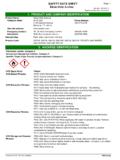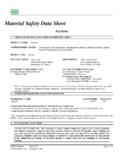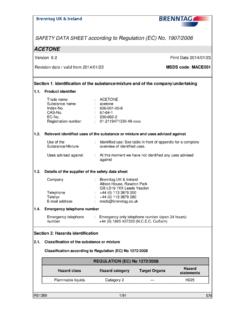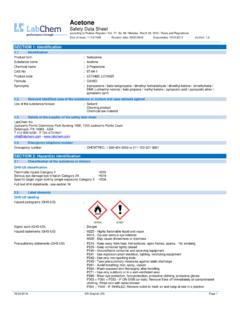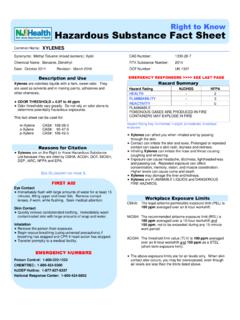Transcription of METHOD 323 MEASUREMENT OF FORMALDEHYDE …
1 METHOD 323 8/7/2017 1 While we have taken steps to ensure the accuracy of this Internet version of the document, it is not the official version. To see a complete version including any recent edits, visit: and search under Title 40, Protection of Environment. METHOD 323 MEASUREMENT OF FORMALDEHYDE EMISSIONS FROM NATURAL GAS-FIRED STATIONARY SOURCES ACETYL ACETONE DERIVITIZATION METHOD Introduction. This METHOD describes the sampling and analysis procedures of the acetyl acetone colorimetric METHOD for measuring FORMALDEHYDE emissions in the exhaust of natural gas-fired, stationary combustion sources. This METHOD , which was prepared by the Gas Research Institute (GRI), is based on the Chilled Impinger Train METHOD for Methanol, Acetone, Acetaldehyde, Methyl Ethyl Ketone, and FORMALDEHYDE (Technical Bulletin No. 684) developed and published by the National Council of the Paper Industry for Air and Stream Improvement, Inc.
2 (NCASI). However, this METHOD has been prepared specifically for FORMALDEHYDE and does not include specifications ( , equipment and supplies) and procedures ( , sampling and analytical) for methanol, acetone, acetaldehyde, and methyl ethyl ketone. To obtain reliable results, persons using this METHOD should have a thorough knowledge of at least Methods 1 and 2 of 40 CFR part 60, appendix A-1; METHOD 3 of 40 CFR part 60, appendix A-2; and METHOD 4 of 40 CFR part 60, appendix A-3. Scope and Application Analytes. The only analyte measured by this METHOD is FORMALDEHYDE (CAS Number 50-00-0). Applicability. This METHOD is for analyzing FORMALDEHYDE emissions from uncontrolled and controlled natural gas-fired, stationary combustion sources. Data Quality Objectives. If you adhere to the quality control and quality assurance requirements of this METHOD , then you and future users of your data will be able to assess the quality of the data you obtain and estimate the uncertainty in the measurements.
3 Summary of METHOD . An emission sample from the combustion exhaust is drawn through a midget impinger train containing chilled reagent water to absorb FORMALDEHYDE . The FORMALDEHYDE concentration in the impinger is determined by reaction with acetyl acetone to form a colored derivative which is measured colorimetrically. Definitions [Reserved] Interferences. The presence of acetaldehyde, amines, polymers of FORMALDEHYDE , periodate, and sulfites can cause interferences with the acetyl acetone procedure which is used to determine the FORMALDEHYDE concentration. However, based on experience gained from extensive testing of natural gas-fired combustion sources using FTIR to measure a variety of compounds, GRI expects only acetaldehyde to be potentially present when combusting natural gas. Acetaldehyde METHOD 323 8/7/2017 2 has been reported to be a significant interference only when present at concentrations above 50 ppmv.
4 However, GRI reports that the concentration of acetaldehyde from gas-fired sources is very low (typically below the FTIR detection limit of around ppmv); therefore, the potential positive bias due to acetaldehyde interference is expected to be negligible. Safety Prior to applying the METHOD in the field, a site-specific Health and Safety Plan should be prepared. General safety precautions include the use of steel-toed boots, safety glasses, hard hats, and work gloves. In certain cases, facility policy may require the use of fire-resistant clothing while on-site. Since the METHOD involves testing at high-temperature sampling locations, precautions must be taken to limit the potential for exposure to high-temperature gases and surfaces while inserting or removing the sample probe. In warm locations, precautions must also be taken to avoid dehydration.
5 Potential chemical hazards associated with sampling include FORMALDEHYDE , nitrogen oxides (NOX), and carbon monoxide (CO). Formalin solution, used for field spiking, is an aqueous solution containing FORMALDEHYDE and methanol. FORMALDEHYDE is a skin, eye, and respiratory irritant and a carcinogen, and should be handled accordingly. Eye and skin contact and inhalation of FORMALDEHYDE vapors should be avoided. Natural gas-fired combustion sources can potentially emit CO at toxic concentrations. Care should be taken to minimize exposure to the sample gas while inserting or removing the sample probe. If the work area is enclosed, personal CO monitors should be used to insure that the concentration of CO in the work area is maintained at safe levels. Potential chemical hazards associated with the analytical procedures include acetyl acetone and glacial acetic acid.
6 Acetyl acetone is an irritant to the skin and respiratory system, as well as being moderately toxic. Glacial acetic acid is highly corrosive and is an irritant to the skin, eyes, and respiratory system. Eye and skin contact and inhalation of vapors should be avoided. Acetyl acetone and glacial acetic acid have flash points of 41 C ( F) and 43 C ( F), respectively. Exposure to heat or flame should be avoided. Equipment and Supplies Sampling Probe. Quartz glass probe with stainless steel sheath or stainless steel probe. Teflon Tubing. Teflon tubing to connect the sample probe to the impinger train. A heated sample line is not needed since the sample transfer system is rinsed to recover condensed FORMALDEHYDE and the rinsate combined with the impinger contents prior to sample analysis. Midget Impingers. Three midget impingers are required for sample collection.
7 The first impinger serves as a moisture knockout, the second impinger contains 20 mL of reagent water, and the third impinger contains silica gel to remove residual moisture from the sample prior to the dry gas meter. METHOD 323 8/7/2017 3 Vacuum Pump. Vacuum pump capable of delivering a controlled extraction flow rate between and L/min. Flow MEASUREMENT Device. A rotameter or other flow MEASUREMENT device is required to indicate consistent sample flow. Dry Gas Meter. A dry gas meter is used to measure the total sample volume collected. The dry gas meter must be sufficiently accurate to measure the sample volume to within 2 percent, calibrated at the selected flow rate and conditions actually encountered during sampling, and equipped with a temperature sensor (dial thermometer, or equivalent) capable of measuring temperature accurately to within 3 C ( F).
8 Spectrophotometer. A spectrophotometer is required for FORMALDEHYDE analysis, and must be capable of measuring absorbance at 412 nm. Reagents and Standards Sampling Reagents Reagent water. Deionized, distilled, organic-free water. This water is used as the capture solution, for rinsing the sample probe, sample line, and impingers at the completion of the sampling run, in reagent dilutions, and in blanks. Ice. Ice is necessary to pack around the impingers during sampling in order to keep the impingers cold. Ice is also needed for sample transport and storage. Analysis Acetyl acetone Reagent. Prepare the acetyl acetone reagent by dissolving g of ammonium acetate in 50 mL of reagent water in a 100-mL volumetric flask. To this solution, add mL of acetyl acetone and mL of glacial acetic acid. Mix the solution thoroughly, then dilute to 100 mL with reagent water.
9 The solution can be stored in a brown glass bottle in the refrigerator, and is stable for at least two weeks. FORMALDEHYDE . Reagent grade. Ammonium Acetate Glacial Acetic Acid Sample Collection, Preservation, Storage, and Transport Pre-test Collect information about the site characteristics such as exhaust pipe diameter, gas flow rates, port location, access to ports, and safety requirements during a pre-test site survey. You should then decide the sample collection period per run and the target sample flow rate based on METHOD 323 8/7/2017 4 your best estimate of the FORMALDEHYDE concentration likely to be present. You want to assure that sufficient FORMALDEHYDE is captured in the impinger solution so that it can be measured precisely by the spectrophotometer. You may use Equation 323-1 to design your test program. As a guideline for optimum performance, if you can, design your test so that the liquid concentration (Cl) is approximately 10 times the assumed spectrophotometer detection limit of g/mL.
10 However, since actual detection limits are instrument specific, we also suggest that you confirm that the laboratory equipment can meet or exceed this detection limit. Prepare and then weigh the midget impingers prior to configuring the sampling train. The first impinger is initially dry. The second impinger contains 20 mL of reagent water, and the third impinger contains silica gel that is added before weighing the impinger. Each prepared impinger is weighed and the pre-sampling weight is recorded to the nearest gm. Assemble the sampling train (see Figure 1). Ice is packed around the impingers in order to keep them cold during sample collection. A small amount of water may be added to the ice to improve thermal transfer. Perform a sampling system leak check (from the probe tip to the pump outlet) as follows: Connect a rotameter to the outlet of the pump.











